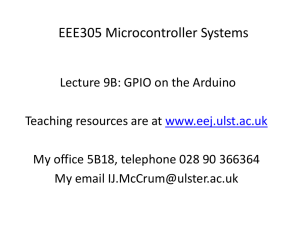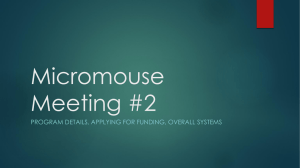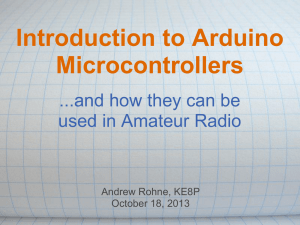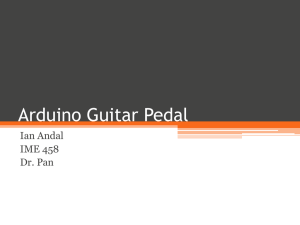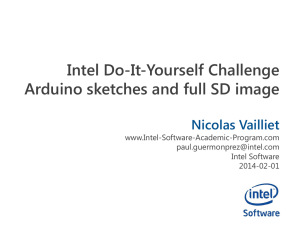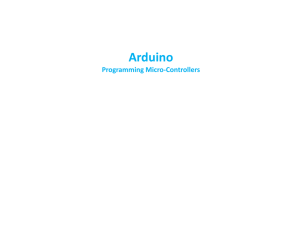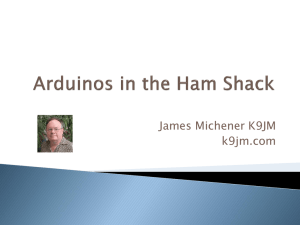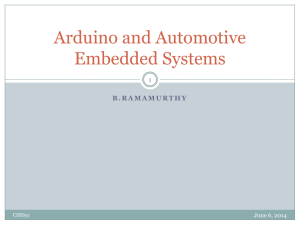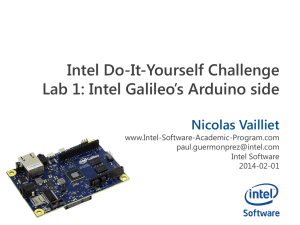DIY Photogates Made Easy - St. Cloud State University
advertisement
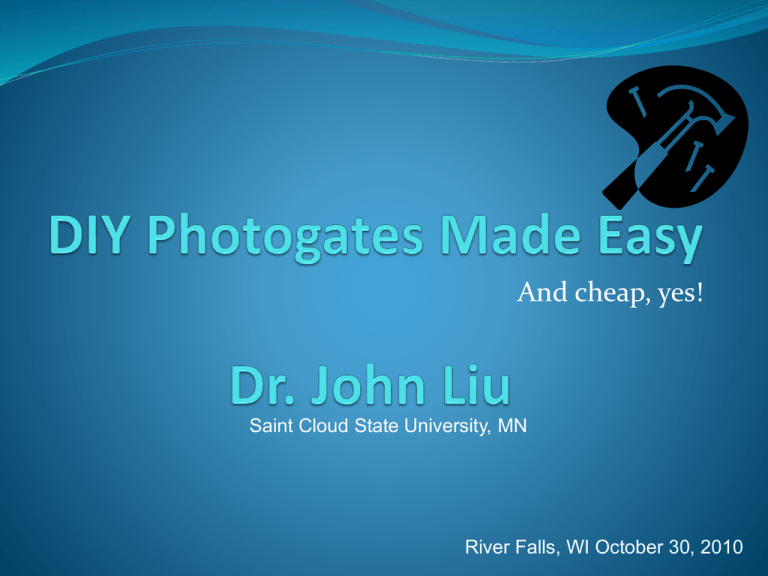
And cheap, yes! Saint Cloud State University, MN River Falls, WI October 30, 2010 What are photogates? Photogates measure time with millisecond accuracy. With known distance, photogate timers can calculate period, speed, angular speed, acceleration, etc. One can do Newton’s 2nd law, conservation of momentum and energy etc. with photogates. Photogate systems are carried by all major vendors. You can DIY a commercial-quality system. You only spend a fraction of the cost. Comparison Pasco standalone $400 Vernier PC-based $150+software DIY less than $60 Works with existing gates What you need? Parts: Arduino microcontroller development board $25 Photo interrupter modules $2 $4 total Stereo audio jacks 3.5mm $1.5 each $6 total Stereo audio cables 3.5mm $2 $4 total Headers and resistors $2.5 Prototype boards and wires $8 Or PCB (much easier to solder) $20 (cheaper with batch order) Tools: Basic PC/Mac/Linux computer with USB RadioShack soldering set $8 Cutting tools if you use prototype boards Total: $50 if you’re good with proto-boards and diagrams or $60 if you’re not What is an Arduino? Arduino is an open-source, very easy to learn/use physical computing platform Arduino can sense many types of sensors and buttons (analog and digital) Arduino can be programmed to sense its inputs repeatedly Arduino can communicate with a computer via the serial port Arduino has an active online community Initial tests on breadboard Breadboard testing Connections PC interface Very simple setup It is a proof of the concept but is not student-proof! Switching to PCB Shield diagram Shield PCB Arduino spacing Photogate diagram Photogate PCB PCB results Arduino board PCB Populated PCB Connected to photogates Photogate 10mm Improvements All parts are safe and secure Soldering is a breeze Jumper wires to audio cables and stereo jacks Breadboard-bound gates to standalone gates Gates can stay a few meters away from the timer and be mounted Arduino board can be easily taken out for repurposing and put back without having to connect a bunch of wires Program the Arduino Open Arduino environment and load source code Compile source code Download compiled code to Arduino board The PC program Shows live data Options of different measurements Save data automatically Videos How long does it take? Programming the microcontroller – 30s Soldering the PCB – 20 min Or using proto-board – 60 min? (I did the easy way) Running data collection – 30s Securing photogates – depends on your setup Testing everything – 10 min What do you get? You will get one timer You will get two gates Same functionality is sold for $400 at Pasco Your system is pin-compatible with Pasco or Daedalon gates (needs ¼” to 3.5mm converter $2) You’re very happy You’ll likely make more stuff with the Arduino board Who knows? World peace? How accurate is it? Well, it depends on three things: your picket fence, the timing accuracy and the speed being measured. The PC serial limits dt to ~0.1ms timing for two gates Say you use 1.00±0.01cm picket fence machined with a mill. For 1.00m/s speed, you get 1.4%. Boring math: 𝑑𝑣 = 𝑣 1 𝑑𝑥 𝑥 2 𝑑𝑣 = 𝑣 + 𝑑𝑡 𝑥 2 = 1 𝑑𝑥 𝑡 2 𝑥 + 2 𝑑𝑡 𝑡 2 𝑣 𝑑𝑥 𝑥 = 1 ∗ 10−4 2 0.01 + 𝑣 1 ∗ 10−2 2 𝑣2 + 𝑑𝑡 𝑥 2 2 = 10−4 + 10−2 𝑣 2 = 1.4% 𝑖𝑓 𝑣 = 1𝑚/𝑠 Update: Physics shield Compatible with all Arduino boards Two robust RJ11 connectors for sensors LCD and 6 buttons for user interaction GPS connector for GPS applications Real time clock and EEPROM for data logging, timing etc. Brings out all Arduino pins Connectors: Photogate connector Breadboard connector Stereo plug connector Proto-connector Future directions: More functions on the PC photogate program Support more gates (may reduce timing accuracy) Start a blog liudr.wordpress.com for physics projects Develop more shields for physics prototyping Develop upper-division electronics class with Arduino Thank you! Care for some details? 0 5 10 15 20 25 30 35 40 45 50 55 60 65 70 75 80 85 90 95 100 105 110 115 120 125 130 135 140 145 150 dv/v*100% 1.0 1.0 1.0 1.0 1.0 1.0 1.0 1.1 1.1 1.1 1.1 1.1 1.2 1.2 1.2 1.3 1.3 1.3 1.3 1.4 1.4 1.5 1.5 1.5 1.6 1.6 1.6 1.7 1.7 1.8 1.8 dx(cm) dt(ms) x(cm) 0.01 0.1 1 10 100 100 Relative error vs. V 1.9 1.8 1.7 Percentage error of V v (cm/s) 1.6 1.5 1.4 1.3 1.2 1.1 1.0 0 20 40 60 80 Velocity (cm/s) 100 120 140 160 Just links Arduino official site Arduino forum My blog Programs for the photogate shield (on my blog) Parts: Arduino microcontroller development board $25 Photo interrupter modules $2 $4 total Stereo audio jacks 3.5mm $1.5 each $6 total Stereo audio cables 3.5mm $2 $4 total Headers and resistors $2.5 Prototype boards and wires $8 Phi-1 shield (please check my blog)


